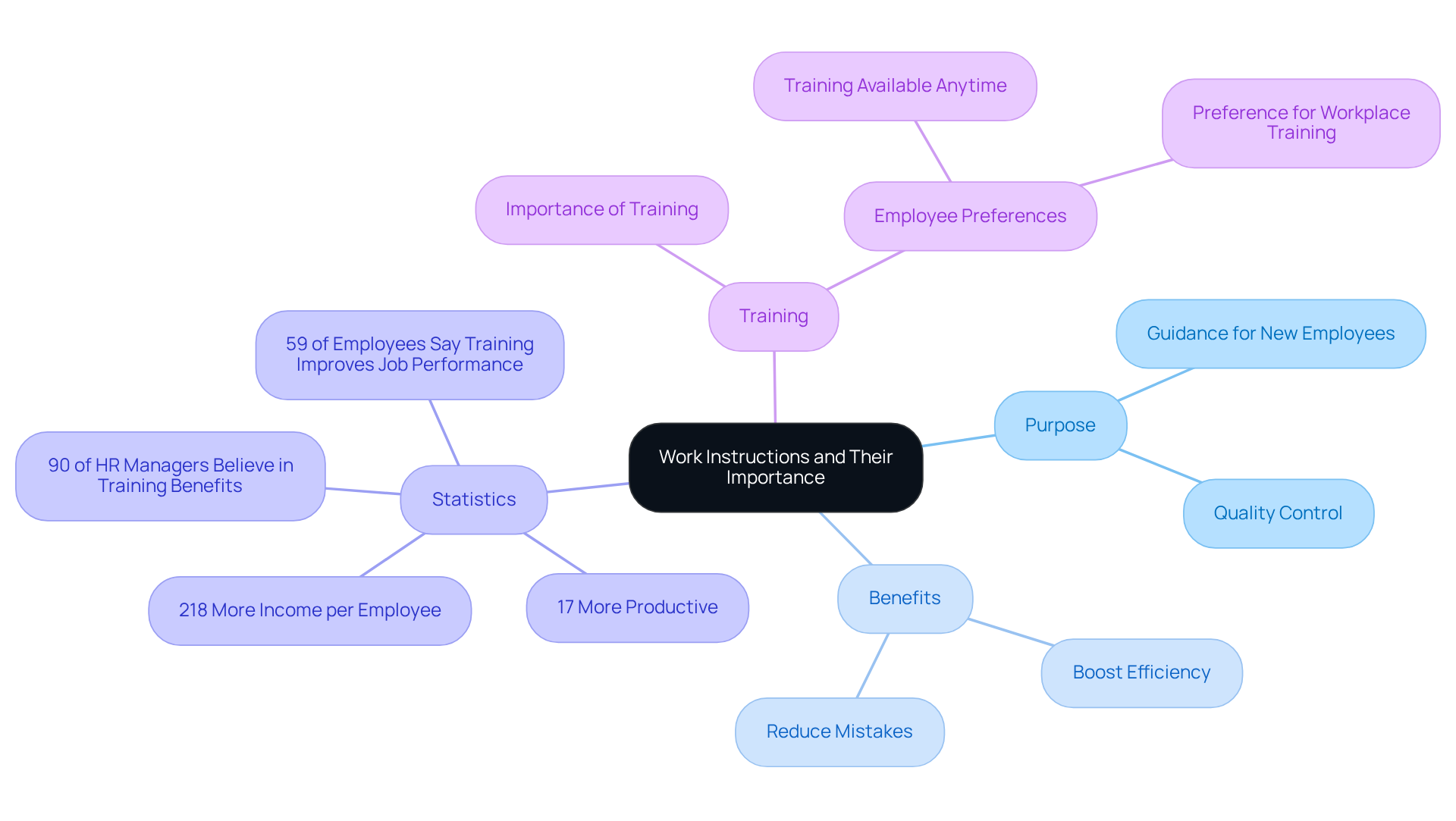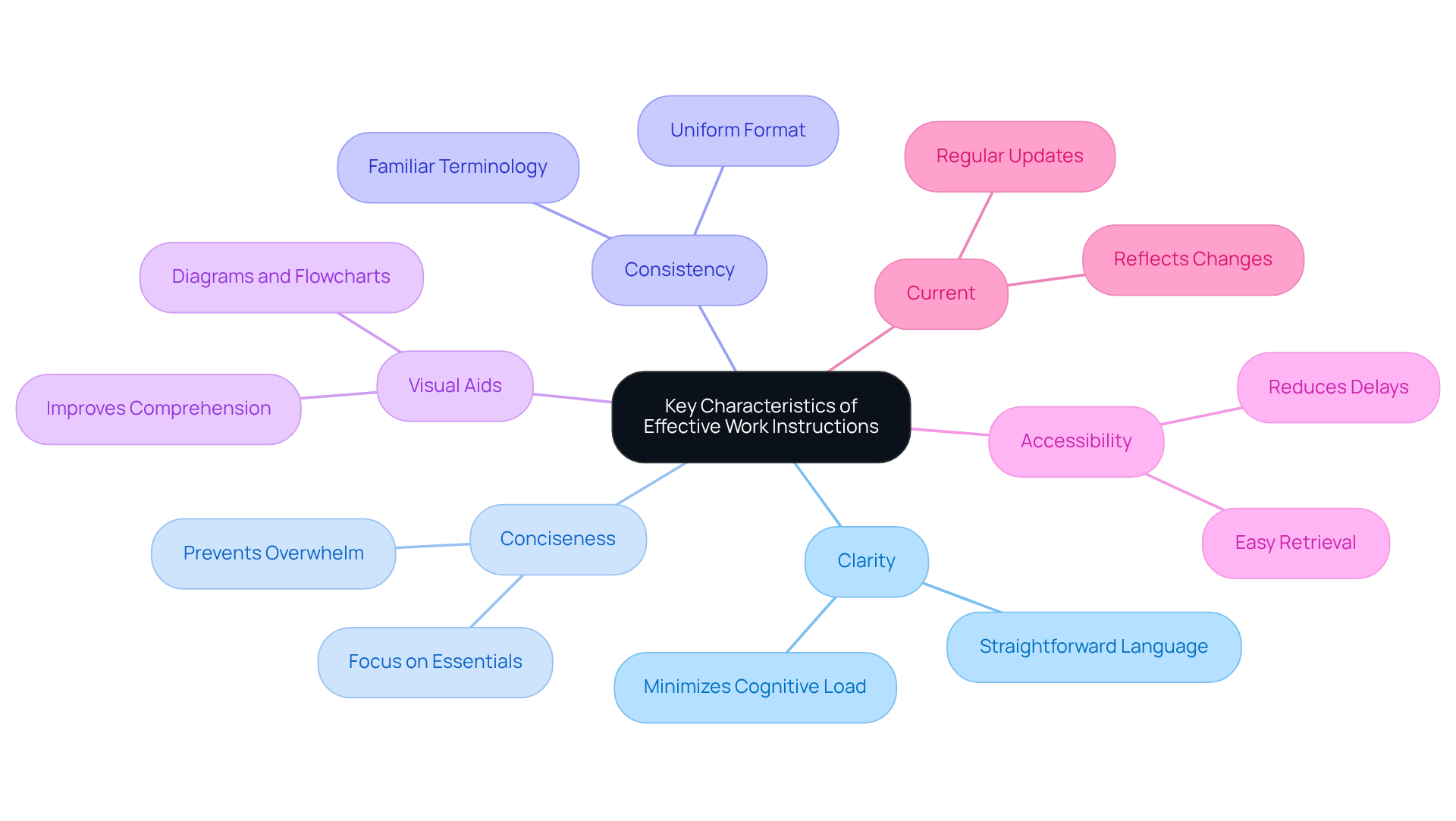
Process Improvement through Documentation
|
October 17, 2025
|
4 Steps on How to Write a Work Instruction Effectively
Overview
You might be wondering how to write effective work instructions that really make a difference. Well, the article lays out a simple four-step process that focuses on:
- Clarity
- Conciseness
- Consistency
- Accessibility
These elements are crucial for boosting training and operational efficiency. And guess what? By offering structured guidelines and keeping everything up to date, organizations can actually cut down on errors and ramp up productivity. In fact, statistics show that comprehensive training can lead to a whopping 17% increase in productivity and even up to 218% more income per employee. So, let’s dive into how you can make this work for you!
Key Highlights:
- Work instructions are step-by-step guidelines essential for training, reducing mistakes, and maintaining quality standards.
- Effective guidelines lead to increased productivity, with companies seeing a 17% boost when staff receive proper training.
- Robust training programmes can result in 218% more income per employee compared to those without structured training.
- Key characteristics of effective work instructions include clarity, conciseness, consistency, visual aids, accessibility, and currency.
- Common issues in writing work instructions include lack of clarity, inconsistency, excessive detail, obsolete information, and inaccessibility.
- Regular updates and feedback from employees are crucial for maintaining the relevance and effectiveness of work instructions.
Introduction
Crafting effective work instructions is a key part of operational success in any organization. You might be wondering how these step-by-step guides can do more than just streamline processes; they can actually boost productivity, cut down on errors, and create a culture of continuous improvement. But here's the kicker: despite their importance, many people find it tough to create instructions that are clear, concise, and engaging.
So, how can organizations make sure their work instructions not only meet employees' needs but also drive efficiency and effectiveness in their operations? Let's dive into that!
Define Work Instructions and Their Importance
You might be wondering what work guidelines really are. Well, they're those handy, step-by-step instructions on how to write a work instruction that assist you in navigating specific activities or processes in an organization. Think of them as essential tools for training new employees, ensuring everyone is on the same page when it comes to task execution, and keeping quality standards in check. The importance of these guidelines is huge—they help reduce mistakes, boost efficiency, and ensure everyone is following safety and operational rules. By providing clear and straightforward guidance on how to write a work instruction, organizations can ensure that all team members understand the processes, which leads to smoother operations and better overall performance.
Now, here’s something interesting: businesses that implement comprehensive task guidelines often see a noticeable increase in efficiency. In fact, research shows that companies become 17% more productive when their staff receives proper training. Plus, 90% of HR leaders believe that training plays a key role in enhancing productivity and development. This really highlights how vital effective guidelines are for building a skilled workforce. And get this—companies with robust training programs have been found to generate a whopping 218% more income per employee compared to those without structured training.
In practice, organizations that focus on solid guidelines on how to write a work instruction not only improve training effectiveness but also cultivate a culture of continuous improvement. This approach keeps employees engaged, as 93% of workers say they want training that’s easy to complete and understand. And with 59% of organizations struggling to find qualified workers, understanding how to write a work instruction is crucial for closing those skill gaps and boosting both operational efficiency and employee satisfaction. So, what do you think? Isn’t it time to rethink how we approach training and documentation?

Follow a Step-by-Step Process for Writing Work Instructions
- Identify the Activity: You might be wondering how to kick things off. Start by selecting a specific activity or process that’s frequently performed and critical to operations, which will guide you on how to write a work instruction. This way, your documentation will focus on those essential activities that really impact productivity.
- Gather Information: Next up, let’s collect all the relevant info about the task at hand. This means diving into existing documentation, chatting with experienced employees, and figuring out what tools or resources you’ll need. Involving operators in this phase not only boosts ownership but also leads to better adherence, since their insights can help create more efficient guidance.
- Outline the Steps: Now, let’s break it down. Create a rough outline of the steps involved in completing the assignment. By chunking the process into manageable parts, you’ll improve clarity and align with best practices that emphasize using specific language and accurate measurements to reduce confusion.
- Compose the guidelines on how to write a work instruction: Using that outline, it’s time to craft clear and concise directives for each step. Keep the language simple and active to enhance understanding. And don’t forget about visual aids! Diagrams or flowcharts can significantly boost comprehension, making those complex tasks a breeze to follow. Studies show that visual aids are a game-changer for understanding, so they’re definitely worth incorporating into your operational guidelines.
- Examine and Modify: After you’ve put together the procedures, take a moment to assess them for clarity and thoroughness. Bring in team members who actually perform the task to gather feedback and suggestions for improvements. Regularly checking in and updating procedures is key for operational efficiency and is essential for understanding how to write a work instruction that ensures they remain relevant and effective.
- Format and Finalize: Finally, let’s get that document looking good. Format it for easy readability by using bullet points, headings, and visuals where it makes sense. A well-organized layout doesn’t just save time in creating guidelines; it also enhances clarity, making it easier for staff to understand the processes. Plus, it’s super important to make sure task guidelines are accessible to everyone, as this really boosts usability. Once everything’s finalized, don’t forget to distribute the document to relevant team members to ensure it’s easy for them to access.

Identify Key Characteristics of Effective Work Instructions
You might be wondering how to write a work instruction that makes them truly effective. Well, let’s dive into some key characteristics that can really enhance their utility!
- Clarity is a big one. Instructions should be straightforward and easy to understand—no one wants to wade through jargon or complex language! Clear guidelines help minimize cognitive load, allowing you to focus on the task at hand. As Daniel Croft-Bednarski points out, "Effective work guidelines must be readily available to those who require them."
- Next up is Conciseness. Keeping things brief and focused on the essentials helps prevent overwhelming the reader. This way, you can quickly grasp the key points without having to sift through a bunch of unnecessary details. Who doesn’t love that?
- Then there's Consistency. A uniform format and consistent terminology throughout the document are crucial. This makes it easier for everyone to follow along and encourages familiarity, which is super helpful for employees trying to navigate the guidelines.
- Let’s not forget about Visual Aids! Incorporating diagrams, screenshots, or flowcharts can significantly boost understanding and retention. Studies show that visual aids can improve comprehension by up to 31%, especially in complex tasks where clarity is key. That’s a pretty compelling reason to include some visuals!
- Accessibility is another important factor. Work guidelines should be easy for all team members to access, whether through a centralized digital platform or printed copies. When guidelines are readily available, it reduces delays and misunderstandings, allowing staff to consult them as needed. Plus, case studies have shown that digital accessibility increases the chances of employees using the SWIs correctly.
- And of course, we need to keep things Current. Regular assessments and updates to procedures are essential to reflect any changes in processes or tools. Keeping guidelines up-to-date ensures they remain relevant and useful, helping to avoid mistakes that could arise from outdated information. As various studies note, SWIs need to evolve over time to keep pace with changes in processes and technologies.
By focusing on these essential traits, organizations can create efficient guidelines on how to write a work instruction that not only direct employees but also enhance overall operational effectiveness. So, what are you waiting for? Let’s get started on making your work instructions the best they can be!

Troubleshoot Common Issues in Writing Work Instructions
When you're crafting work instructions, you might run into a few common hiccups:
- Lack of Clarity: Confusing instructions can lead to errors, right? Simplifying your language and breaking down complex steps into smaller, manageable parts can really boost understanding. Concise guidance lowers the risk of errors, which lead to about $10 billion in manufacturing losses each year! Plus, did you know that 23% of unexpected downtime in manufacturing comes from human mistakes? That really highlights how important clarity is in your guidelines.
- Inconsistency: Ever noticed how variations in terminology and formatting can create confusion? To keep things uniform, it’s a great idea to establish a style guide that everyone on the team can stick to. This way, everyone understands how to write a work instruction using the same language and structure, making life a lot easier.
- Overly Detailed: Too much information can be overwhelming, can’t it? Focus on the essential steps and think about offering additional resources for those more complex tasks. This helps prevent information overload while keeping critical actions crystal clear. And hey, incorporating visual aids like diagrams or photos can really enhance understanding and engagement when learning how to write a work instruction!
- Obsolete Details: It’s crucial to regularly review and update your operational guidelines to reflect current practices. How about scheduling periodic audits every 6-12 months or after any significant process changes? Staying relevant and accurate is key! Don’t forget, ignoring feedback from operators can lead to ongoing mistakes, so setting up feedback loops is essential for continuous improvement.
- Inaccessibility: Make sure that task guidelines are easy for all team members to access. Using a centralized digital platform for storage and sharing can help everyone get to the information they need instantly, boosting efficiency and productivity.
By proactively addressing these challenges, you can significantly enhance the quality and efficiency of your procedures, particularly in how to write a work instruction, helping you achieve your goals and drive operational success. As Daniel Croft, a Continuous Improvement Manager, puts it, "Clear guidelines decrease the likelihood of errors and flaws." Plus, case studies from Republic Manufacturing and KONE show that implementing visual work instructions can lead to major operational improvements, like cutting down on inspection and production times. So, what’s stopping you from making these changes?

Conclusion
Writing effective work instructions is super important for boosting operational efficiency and making sure everyone on the team is on the same page with their tasks. You might be wondering how that works, right? Well, by providing clear, concise, and easy-to-follow guidelines, organizations can really cut down on errors, ramp up productivity, and create a culture of continuous improvement. This structured approach not only helps with employee training but also bridges those pesky skill gaps that are so crucial in today’s competitive world.
Let’s dive into some key insights. Clarity, conciseness, consistency, and the use of visual aids are all vital when crafting effective work instructions. Following a step-by-step process—like identifying activities, gathering information, outlining steps, and regularly updating procedures—can help ensure that your guidelines stay relevant and useful. Plus, tackling common issues such as lack of clarity or inconsistency can really boost the effectiveness of these instructions.
Ultimately, investing time and resources into creating effective work instructions is a smart move that pays off in productivity and employee satisfaction. So, organizations should definitely prioritize developing comprehensive work instructions. By utilizing best practices and gathering continuous feedback, they can refine their processes. This way, they not only minimize mistakes and downtime but also empower their workforce, leading to long-term operational success. Sounds like a win-win, right?
Frequently Asked Questions
What are work instructions?
Work instructions are step-by-step guidelines that assist individuals in navigating specific activities or processes within an organization. They serve as essential tools for training new employees and ensuring consistent task execution.
Why are work instructions important?
Work instructions are important because they help reduce mistakes, boost efficiency, and ensure compliance with safety and operational rules. They provide clear guidance, leading to smoother operations and better overall performance.
How do work instructions impact productivity?
Research shows that companies with proper training and comprehensive task guidelines see a 17% increase in productivity. Additionally, 90% of HR leaders believe training enhances productivity and development.
What financial benefits do companies gain from effective training programs?
Companies with robust training programs generate 218% more income per employee compared to those without structured training.
How do work instructions contribute to employee engagement?
Organizations that focus on clear guidelines for writing work instructions improve training effectiveness and cultivate a culture of continuous improvement, which keeps employees engaged. About 93% of workers prefer training that is easy to complete and understand.
What challenges do organizations face regarding workforce skills?
59% of organizations struggle to find qualified workers, making it crucial to understand how to write work instructions to close skill gaps and enhance operational efficiency and employee satisfaction.
👍
What others are liking
5 Steps to outline your ideal documentation structure
5 MINS READ
Where to start the your journey of mapping out your ideal documentation structure, aligning it with the very heartbeat of your organization?
Defining a winning level of detail in your process
3 MINS READ
What is too much detail, and what is too little? This article described in that winning level detail about what detail is enough.





